The 2018 Apple iPad Pro (11-Inch) Review: Doubling Down On Performance
by Brett Howse & Andrei Frumusanu on December 4, 2018 10:00 AM ESTThe Liquid Retina Display
Apple offers some of the best displays on the market, and the iPad Pro is arguably their best display available. What Apple calls a Liquid Retina display is a 264 pixel-per-inch masterpiece. The 11-inch model we are reviewing holds a 2388x1668 7:5 aspect ratio panel, while the larger 12.9-inch model uses a 4:3 2732x2048 panel.
There’s a lot that sets Apple apart from other manufacturers on the market. The company has taken display accuracy seriously longer than anyone outside of the professional field. The display in the iPad Pro is also a P3 D65 gamut display, but thanks to the color management system that Apple moved over from the Mac, it simultaneous offers near-perfect sRGB reproduction as well as near-perfect P3 reproduction whenever an app or image specifically says it's P3. There’s no compromise on offering the P3, and no need to change the gamut on the display to match different color spaces. It’s a P3 display where sRGB is properly mapped.
In addition, Apple’s iPad Pro offers their ProMotion technology, which means it is a 120 Hz display, but one that supports variable refresh rates in order to lower the display's refresh rate for power management purposes. The iPad Pro will go as low as 24 Hz, presumably chosen to match the framerate of most movies. Apple also carries over its True Tone functionality, where ambient light sensors change the white point of the display to make it more suited to the environment it is in. It’s one of those features you never really knew you needed until you see it in action.
The fully laminated display also offers Apple’s industry leading antireflective coating, which Apple rates at 1.8% reflectivity, improving the results outdoors dramatically over most devices, and of course there is a fingerprint-resistant oleophobic coating as well.
Apple rates the latest iPads at up to 600 nits of brightness too, so pretty much no matter where you are, the combination of the high brightness and the antireflective coating should make for a great viewing experience.
To test the display characteristics, we turn to SpectraCal’s CalMAN software suite, along with an X-Rite i1Display Pro colorimeter for brightness and contrast readings, and the X-Rite i1Pro 2 spectrophotometer for color accuracy readings.
Brightness and Contrast
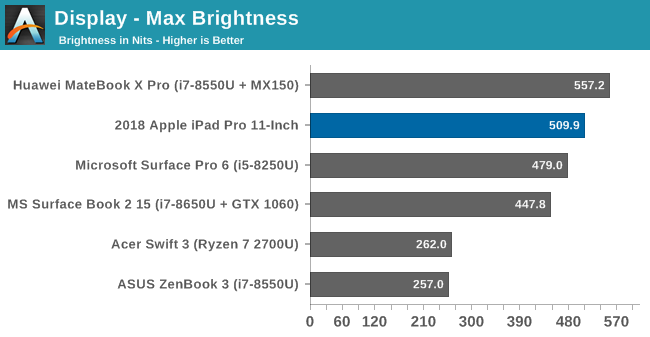
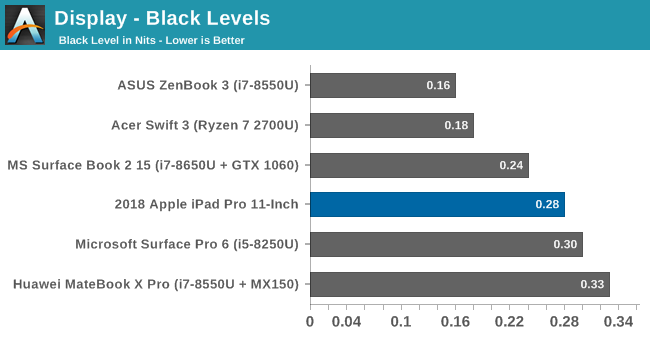
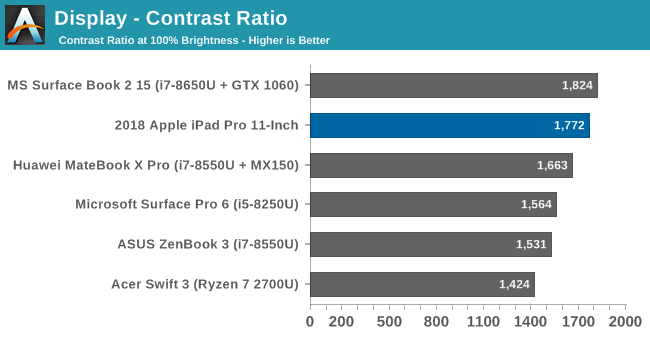
Under our test conditions the iPad Pro could not quite hit the 600 nits that Apple advertises, but at 500 nits it is still plenty bright. Couple that with the excellent contrast ratio of almost 1800:1, and things are off to a good start.
Grayscale
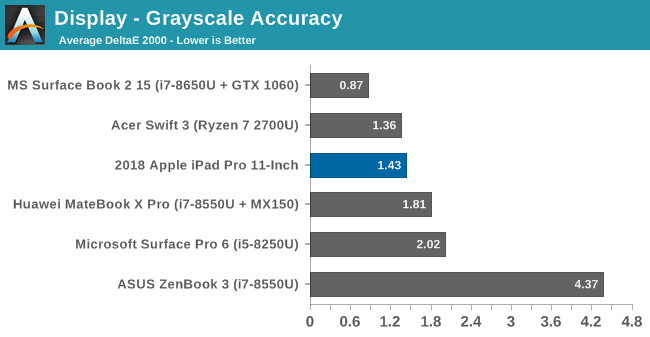
The average dE2000 of 1.43 is a fantastic result, but the gamma isn’t quite perfect, dropping off near 100% because the display was slightly too bright. Unfortunately, the red results were quite low throughout the entire range leading to a slightly cooler display white point, but this is all quite minor.
Gamut
First let’s take a look at sRGB:

As you can see, the sRGB values are almost perfectly mapped into the P3 D65 gamut, and the average error level of just over 1.09 is simply fantastic. All of the primary and secondary values are close to perfect, except red which was a bit low at 100% red, as we saw in the grayscale results.
Next up, P3 D65:
As with the sRGB results, the P3 D65 gamut is also almost perfect. The beauty of color management means that there’s no work for the user to get the benefit of both P3 and sRGB.
Saturation

The saturation sweep was run in sRGB, and as you can see from the graphs, all along all of the primary and secondary colors the error level is basically imperceptible to the human eye.
Gretag Macbeth
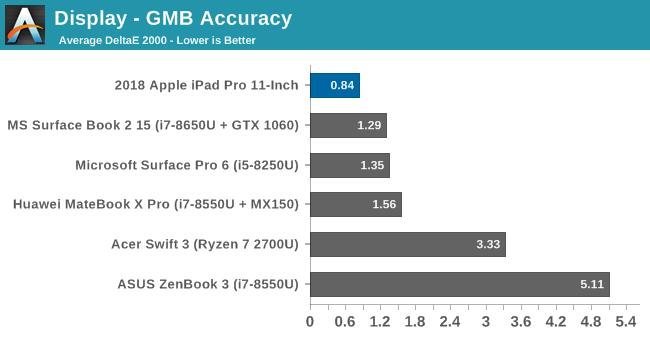
Finally, the Gretag Macbeth test is a more comprehensive test, hitting colors outside of the primary and secondary colors, including the important skin tones. The error level is practically perfect, with no single color even hitting an error level of 2.0.
Display Conclusion
The iPad Pro simply offers one of the best displays on any electronic device. Color accuracy is superb, in both the P3 and sRGB gamuts, and thanks to iOS supporting full color management, customers don’t have to worry about if they are working on a P3 or sRGB image. The addition of True Tone makes for an incredibly pleasing white point in pretty much any situation, and the 120 Hz display refresh rate makes for smooth scrolling, while stepping down to lower refresh rates to conserve power when the display is static.


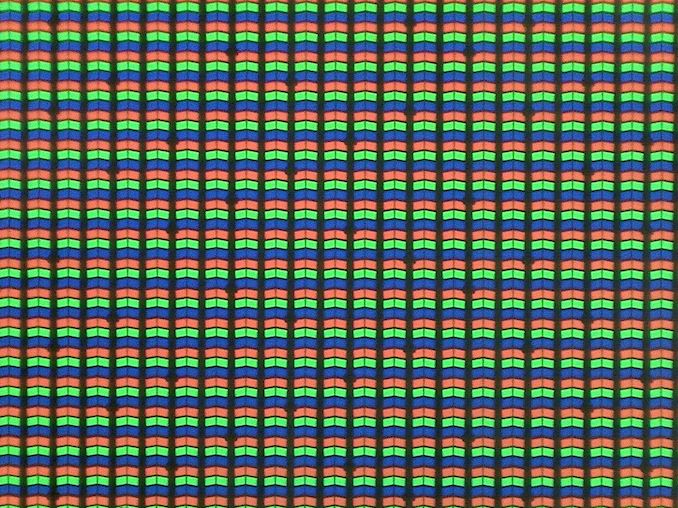


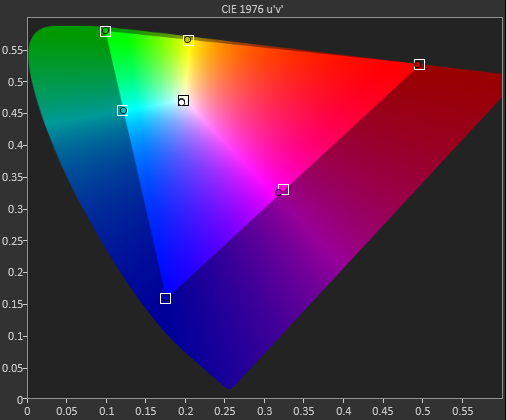










145 Comments
View All Comments
peevee - Monday, December 10, 2018 - link
Ok, a tablet for $1800, a keyboard for $180... Apple is just trolling now.Socius - Tuesday, December 11, 2018 - link
Don’t forget $130 for the pencil. Lol. And the keyboard is just absolute trash. All I want is the surface pro keyboard on the iPad. Cheaper too.peevee - Monday, December 10, 2018 - link
"But iOS is certainly less RAM hungry compared to the PC, thanks to the more limited applications available"The statement makes no sense. If you need RAM for something, say, precessing of a photo from a raw format, IOS or Windows - it does not matter.
For code ARM64 actually requires more RAM than x64, but that pales in comparison to photo/video requirements.
blackcrayon - Monday, December 10, 2018 - link
Well in your example it doesn't matter, but in many other examples it does. The desktop versions of Word for Windows or Mac for that matter are a lot more powerful than Word for iOS, thus iOS needs less memory to run its "more limited" version of Word...Socius - Tuesday, December 11, 2018 - link
Word on iOS is a joke. And there’s no reason for it. Word is not a heavy application. If they’re forcing you to buy a monthly subscription to use it, they could at least make it more like the desktop version.Socius - Tuesday, December 11, 2018 - link
Between memory compression and 1GB/s nvme ssd it becomes far more manageable than many expect. Guaranteed once photoshop comes out, the 6GB iPad Pro 1tb will outperform the 8gb surface pro 6 at handling large multi layer files.peevee - Monday, December 10, 2018 - link
Macbook Air is a software feature (recompilation from x64 to ARM8, likely better done in App Store once with full optimization) away from switching to Apple's own SOCs.Is there a x64 to LLVM compiler?
McD - Sunday, December 16, 2018 - link
Good write up as ever but still some niggling general commentary;1) we don’t need Adobe Photoshop to provide real-world productivity validation when we already have Affinity Photo. We already know the integrated CPU/GPU architecture provide a huge boost over discrete components.
2) no GUI PC provides full file-system access either. On my iPad provides the same local system that has PC users running round in circles with Admins in hot pursuit. Cloud Drive (take your pick) and file localisation has been a way better prospect for the last few years.
techgadgetgeek - Monday, December 17, 2018 - link
There is one thing I did not see done in this test which would have been great to see. Previously when syncing an iPad or iPhone with a MacBook Pro via iTunes a sync would take ages to sync depending on how much you had to backup to MacBook first before syncing. The new iPad Pro uses a USB type C cable and is supposed to have faster transfer speeds. I would like to know how fast data transfer for syncing is on the new iPad Pro compared to the last generation iPad. There are different cables out there these days. Would be nice to see the stock iPad Pro cable used for a sync compared to previous cable on last generation iPad. Also would be nice to see it tested with a USB C 3.1 and 3.2 Type C cable along with a Thunderbolt 3 Cable to see if transfer speeds for syncing make a big difference or not. Surprised this was not testedtecsi@pacbell.net - Tuesday, January 29, 2019 - link
The charts need to include the iPad Pro 10.5” which is the more relevant comparison. Can you update and repost?I expect most people would be intersted in this comparison.